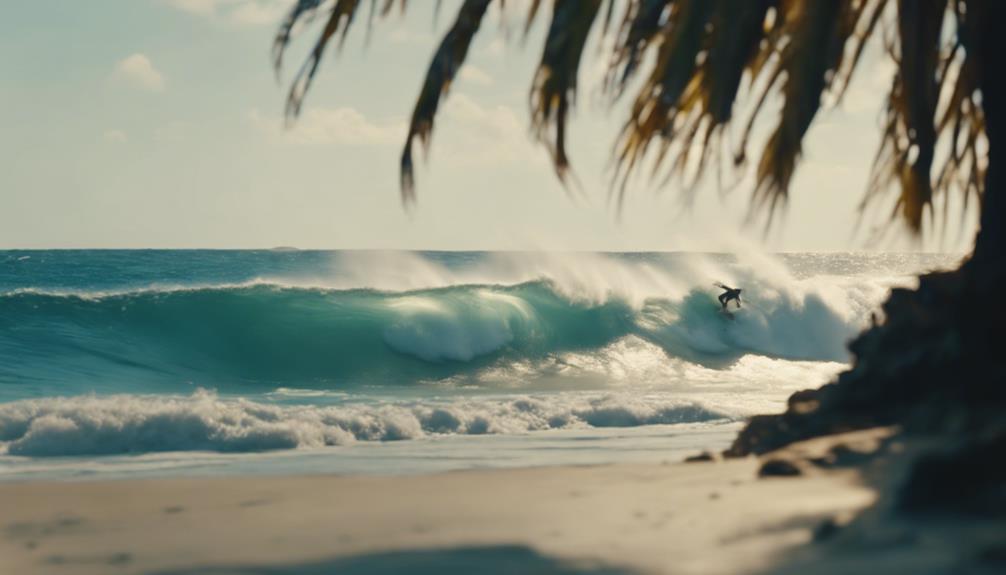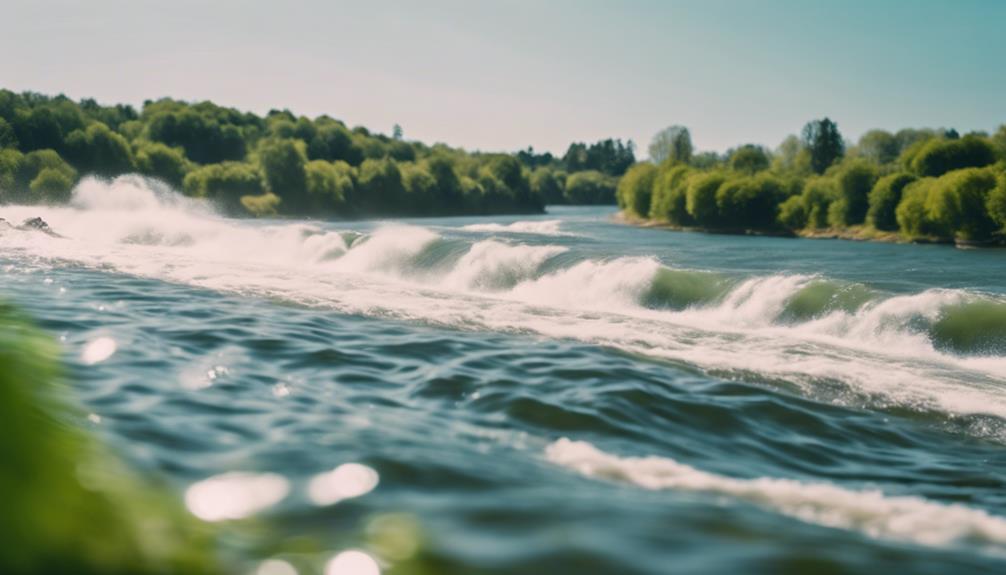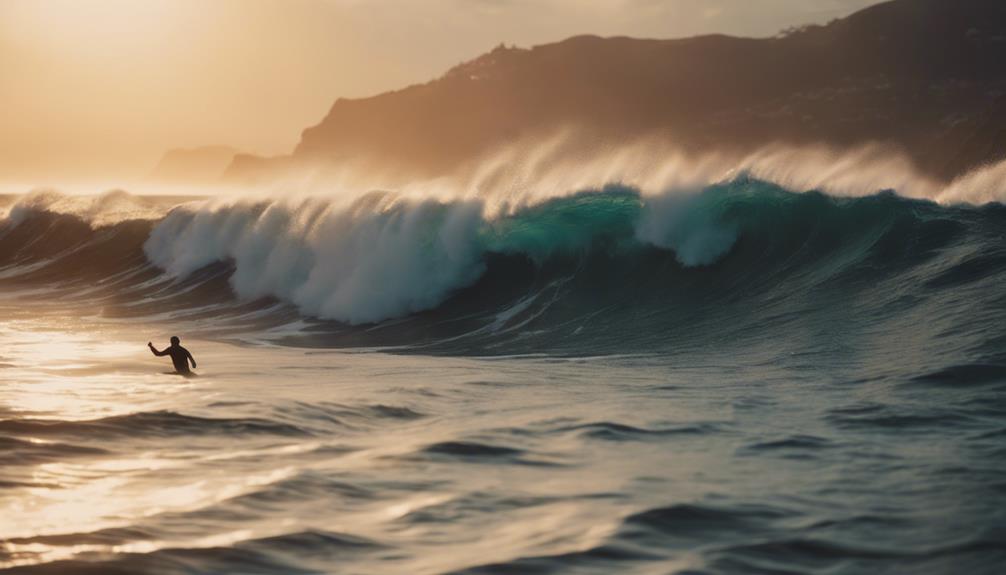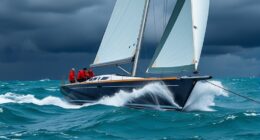When you hit the waves, you'll encounter a range of types that cater to different skill levels. Beach breaks are perfect for beginners, offering soft landings on sandy seabeds. Experienced surfers often seek reef breaks for powerful, hollow waves. Point breaks provide long, peeling rides, ideal for practicing maneuvers. Shorebreak waves deliver thrilling crashes close to the shore, while river waves offer unique stationary experiences. Wave pools create controlled environments for consistent practice. Each wave type comes with its own challenges and excitement, making your surfing journey diverse and engaging. There's much more to explore about them, so keep going!
Key Takeaways
- Beach Breaks are ideal for beginners, featuring soft landings and unpredictable wave shapes on sandy seabeds.
- Reef Breaks create powerful, hollow waves over coral or rocky formations, suitable for experienced surfers.
- Point Breaks offer long, peeling rides, allowing for practice of turns with easier paddling access and more predictable waves.
- Shorebreak Waves crash in shallow waters, providing thrilling, but often unpredictable rides with a high chance of wipeouts.
Beach Breaks
Beach breaks are perfect for beginner surfers since they feature soft landings on sandy seabeds. These breaks provide a forgiving surf experience, allowing you to focus on honing your skills rather than worrying about harsh falls. The wave shape can vary greatly depending on environmental factors like wind direction and swell size, which means you'll encounter a mix of gentle and more challenging waves.
Locations such as Duranbah in Australia, Cardiff Beach in California, and Fistral Beach in the UK are renowned for their consistent waves, making them popular spots for surf schools. Here, you can practice skills in a safe environment, enjoying the thrill of catching waves without the worry of rocky bottoms.
Since beach breaks are less predictable in wave shape compared to reef breaks, you'll get the chance to adapt your techniques as you ride different types of waves. This variability not only keeps your sessions exciting but also accelerates your learning process.
Reef Breaks

Reef breaks deliver powerful, hollow waves that thrill experienced surfers seeking their next big challenge. These dynamic spots occur when waves break over coral or rocky formations, creating ideal conditions for those looking for barrel rides and consistent breaks. With stable underwater topography, you can predict wave patterns more accurately than at beach breaks. However, be aware of the hazards that come with surfing these areas.
Here are some key features of reef breaks:
- Powerful Waves: They often produce some of the most intense surfable waves.
- Ideal for Experienced Surfers: The conditions challenge even the most skilled surfers.
- Barrel Rides: Many renowned spots are famous for their stunning barrel sections.
- Hazards: Sharp rocks and coral formations can pose risks, especially during larger swells.
Point Breaks

Surfers often appreciate point breaks for their long, peeling rides that provide a perfect setting for practicing turns and maneuvers. These waves form where ocean swells wrap around a coastal point, creating predictable conditions that allow for extended rides. Unlike beach breaks, which can be chaotic, point breaks enable you to focus on your skills without the added stress of unpredictable wave behavior.
Paddling out at point breaks is generally easier, as you can navigate around the impact zone more smoothly. This streamlined entry makes it a favorite for many surfers seeking to maximize their time in the water. However, it's important to keep in mind that point breaks can get crowded, especially during peak surf seasons. Practicing surf etiquette becomes essential in these situations to guarantee everyone has a chance to enjoy their ride.
Notable point breaks like Jeffreys Bay in South Africa and Rincon in California are renowned for their exceptional wave quality. Whether you're a beginner or an advanced surfer, point breaks offer a fantastic opportunity to enhance your maneuverability while enjoying longer, more fulfilling rides.
Shorebreak Waves

Shorebreak waves pack a powerful punch, crashing in shallow water close to the shore and often delivering thrilling barreling rides. For surfers, these waves can be an exhilarating challenge, but they're not for the faint-hearted. You'll need advanced skills and a keen awareness of local hazards to navigate them safely.
Here are some key factors to keep in mind when surfing shorebreak waves:
- Underwater Topography: The ocean floor can create unpredictable conditions, affecting wave formation.
- Swell Direction: Different swell directions can influence how these waves break, altering your surfing experience.
- Wipeouts: Expect the possibility of wipeouts, as these waves crash directly onto the sand with incredible force.
- Powerful Energy: Shorebreak waves are often more powerful than regular beach breaks, demanding respect and skill.
If you decide to tackle these barreling waves, make sure you're prepared for the dynamic environment and the potential for injury. Surf smart and enjoy the ride!
River Waves

When you ride river waves, you experience a unique thrill that ocean surfing can't replicate.
Understanding how these waves form is key, as specific conditions like flow rate and water depth play an essential role.
Popular spots like the Eisbachwelle in Munich and the Zambezi River Wave offer exciting opportunities for both beginners and seasoned surfers.
Unique Riding Experience
River waves offer a thrilling and unique riding experience, allowing you to carve and maneuver endlessly without the hassle of paddling back out. Unlike ocean waves, river waves are stationary, providing consistent wave shapes that make for reliable surfing opportunities year-round. This feature is especially appealing for beginners looking to develop their skills, as you can practice various maneuvers without the unpredictable nature of tides and weather.
Here are some highlights of the unique riding experience on river waves:
- Endless rides: Stay on the wave as long as you can manage.
- Skill development: Hone your techniques in a controlled environment.
- Less crowded: Enjoy a more intimate surfing experience.
- Accessibility: Find river waves in urban settings, like the Eisbachwelle in Munich.
Whether you're a novice or an intermediate surfer, river waves offer a fantastic platform for improvement and enjoyment.
Formation Conditions Explained
To understand how river waves form, you need to contemplate the interplay of water depth, flow speed, and the riverbed's structure.
River waves, also known as stationary waves, arise when water flows over underwater shelves or obstructions, creating a consistent wave that surfers can ride indefinitely. The formation conditions for these waves require a specific combination of depth and flow speed, which can vary considerably from one river to another.
In rivers with sufficient flow, like the Eisbach in Munich, the wave types can differ greatly. Higher flow rates typically generate larger, more powerful river waves, while lower flow rates create smaller, mellower ones. The riverbed structure plays an essential role in shaping these waves, influencing both size and shape.
In this unique surfing environment, surfers often opt for shorter boards or specialized surfboards tailored to the dynamics of river surfing. The stationary nature of river waves allows for continuous practice, making it an ideal setting for skill development.
Popular Locations Highlighted
Surfers flock to iconic spots like the Eisbachwelle in Munich and the Zambezi River Wave in Africa for unforgettable river wave experiences. These locations showcase the incredible wave variety that river waves offer, providing alternatives to traditional ocean swells. You can enjoy unique surf opportunities that allow for skill practice without needing to paddle back out.
Here are some highlights of popular river wave spots:
- Eisbachwelle, Munich: A consistent, urban wave perfect for all skill levels.
- Zambezi River Wave, Africa: Known for its powerful flow and challenging conditions.
- Waimea River Mouth, Hawaii: Combines river dynamics with ocean waves for a unique experience.
- Bend, Oregon: Features a stationary river wave that attracts surfers year-round.
With the ability to ride these waves indefinitely, surfers can truly immerse themselves in their surfing experience.
Just remember, river wave conditions can change, so always check local conditions before heading out to guarantee a great day on the water!
Wave Pools

Wave pools offer a unique surfing experience by providing consistent, controlled conditions that cater to all skill levels. You can practice your skills without worrying about unpredictable surf conditions.
These man-made facilities utilize advanced technology, like air compressors and hydraulic systems, to create a variety of waves that mimic different surf breaks. Whether you're a beginner surfer looking for mellow waves or an advanced surfer seeking a challenge, wave pools have options for everyone.
Notable examples include the Surf Ranch in California, engineered by professional surfer Kelly Slater, and The Wave in Bristol, famous for its diverse wave options. These surf parks are gaining popularity in the surfing community, reflecting a demand for accessible and reliable surf experiences.
In a wave pool, you can enjoy consistent waves that allow for focused practice, whether you want to perfect your technique or just have fun. The safe environment also makes it easier for beginner surfers to build their confidence.
As the trend continues to rise, wave pools are becoming essential venues for surfers of all abilities to hone their skills and enjoy the sport.
Frequently Asked Questions
What Are the 7 Types of Ocean Waves?
You've got seven main types of ocean waves: wind waves, swell, seiche, tsunami, tidal waves, storm surges, and rogue waves. Each type varies in size, shape, and impact, shaping your ocean experience uniquely.
What Type of Waves Do Surfers Prefer?
Choosing waves is like picking a dance partner; you'll find beach breaks perfect for beginners, point breaks for thrill-seekers, and reef breaks for the adventurous. Your preferences will shape your surfing experience, so explore them all!
What Are the Different Types of Waves and What Do They Do?
You'll find various wave types, each offering unique experiences. Beach breaks are gentle, reef breaks challenge you, point breaks deliver long rides, shorebreaks thrill with barreling waves, and wedges surprise with steep, powerful swells. Enjoy exploring!
What Are the Different Types of Waves 4th Grade?
Imagine a canvas where water dances and crashes! You've got gentle ripples, towering waves, and frothy shorebreaks. Each type of wave offers a unique experience, helping you learn and enjoy the ocean's rhythm as you surf.
Conclusion
So, whether you're paddling out at a beach break or catching a gnarly river wave, there's a wave type for everyone.
Each offers its own thrill and challenge, just like trying to find a good Wi-Fi signal at the beach!
Embrace the variety and experiment with different spots to discover what suits your style.
With the right wave, you'll feel like a rockstar riding the tide.
Now, grab your board and hit those waves!










